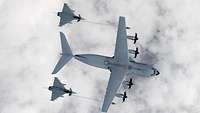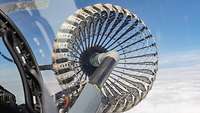When the Air Force refuels above the clouds, precision is required
Pacific Skies- Date:
- Place:
- Alaska
- Reading time:
- 3 MIN


When combat aircraft conduct missions, landing is not always possible. But it is not necessary if there is a “flying gas station” nearby. Air refueling ensures that aircraft can stay in the air much longer, cover longer distances or control larger areas of operations.

A refueling process that takes around ten minutes requires maximum precision and excellent flying skills. In order to master this skill when under stress, it is important to practice air refueling regularly.
Bundeswehr/Christian TimmigThe refueling process usually follows a specific pattern: Flying at high speed and in tactical formation close behind each other, the aircraft to be refueled approach the tanker aircraft from the left and establish visual contact with its crew. They then regroup behind the tail of the tanker until they are instructed to approach the tanker in groups of two up to a distance of 20 meters and in parallel to both wings. Afterwards, they return to the tail of the tanker before breaking away on its right side. The entire operation follows a schedule that is accurate to the minute.
First, the 25-meter-long fuel hoses are extended from the so-called pods. The hose ends are fitted with a refueling drogue, which looks like a shuttlecock and flies freely in the air. Its wire mesh is stretched out by the air flow to form a funnel. The jet pilots are guided by a traffic light system at the wings of the A400M or A330 multi-role tanker transport (MRTTMulti Role Tanker Transport) aircraft. As soon as the jet fighter's refueling probe is close enough, the wind draft on the drogue creates a connection between the tip of the probe and the valve.

Because of the intense air traffic above Central Europe, air refueling areas have been defined which are referred to as “ovals”.
Bundeswehr/Christian TimmigDuring refueling, up to 1,590 kilograms of fuel per minute flow through the hose from one aircraft to another – at an altitude of between 1,500 and 10,000 meters and at a speed of around 500 kilometers per hour. The process usually takes around ten minutes. As the planes are very close to each other and can be jolted by turbulence, the pilots have to be very skillful and steer their planes with maximum precision. These skills are very important, even if the procedure is largely automated and monitored by an air refueling officer via external cameras and screens in the tanker aircraft. Moreover, the speed and altitude of the aircraft involved must remain constant and the jet fighter receiving the fuel must continue to push against the drogue because refueling would otherwise be stopped. Given the high requirements, it is important to practice air refueling regularly in real flight operations. In addition to the drogue system, refueling is also possible using a telescopic boom. This means that almost every aircraft of the NATONorth Atlantic Treaty Organization partners can be refueled. Even darkness is no obstacle: On night flights, the process is supported by infrared control.
Because of the intense air traffic above Central Europe, air refueling areas have been defined which are referred to as “ovals”. One of the goals is to keep the burden on the population as low as possible. In 2022 alone, there were a total of 444 air refueling missions over Germany, each with up to eight receiving aircraft. In many years of air refueling, there have never been any accidents over the Federal Republic. However, civil aircraft are not refueled in flight.
(Incidentally, air refueling is considered to have been invented on 27 June 1923: That day was the first time a hose was used to transfer almost 280 liters of fuel from one aircraft to another at a height of around 150 meters over the USUnited States Air Base Rockwell Field in California.)
by Rüdiger Franz